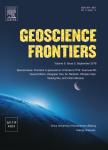A proto-monsoonal climate in the late Eocene of Southeast Asia:Evidence from a sedimentary record in central Myanmar
作者机构:Institute for Biodiversity and Ecosystem Dynamics(IBED)University of Amsterdam1090 GE AmsterdamThe Netherlands Palynova Ltd.1 Mow Fen RoadLittleportCambridgeshire CB61PYUK Department of Earth SciencesRoyal HollowayUniversity of LondonEghamSurrey TW200EXUK Centre de Recherche et d'Enseignement de Géosciences de I'Environnement(CEREGE)Aix-en-ProvenceFrance Institut fur GeowissenschaftenUniversität Potsdam14476 PotsdamGermany Géosciences RennesCNRS and Universitéde Rennes 135042 Rennes CedexFrance Geology DepartmentShwe Bo UniversitySagaing RegionMyanmar Department of GeologyUniversity of YangonPyay RoadYangonMyanmar Badan GeologiJl.Soekarno Hatta No 444BandungBandung 40254Indonesia Geological InstituteRussian Academy of SciencesPyzhevsky Pereulok 7119017 MoscowRussia Birbal Sahni Institute of Palaeosciences53 University RoadLucknow 226007India Department of Earth SciencesUniversity of FlorenceVia G.La Pira 450121 Florenceltaly Department of Earth SciencesMemorial University of New-foundlandSt.John'sNewfoundland A1B 3X5Canada
出 版 物:《Geoscience Frontiers》 (地学前缘(英文版))
年 卷 期:2023年第14卷第1期
页 面:46-63页
核心收录:
学科分类:070904[理学-构造地质学] 0709[理学-地质学] 07[理学] 0708[理学-地球物理学] 0704[理学-天文学]
基 金:the China Scholarship Council(CSC grant 201604910677) the University of Amsterdam the European Research Council Consolidator Grant(MAGIC 649081) the ANR grant ANR-19-ERC7-0007
主 题:Bioclimatic analysis Diversity Monsoon Palynology Sequence biostratigraphy Southeast Asia
摘 要:The Burma Terrane has yielded some of the earliest pieces of evidence for monsoonal rainfall in the Bay of ***,Burmese ecosystems and their potential monsoonal imprint remain poorly *** study focuses on the late Eocene Yaw Formation(23°N)in central Myanmar,which was located near the equator(c.5°N)during the *** quantitatively assessed the past vegetation,climate,and depositional environments with sporomorph diagrams,bioclimatic analysis,and sequence *** calculated the palynological diversity and drew inferences with rarefaction analysis by comparing with four other middle to late Eocene tropical *** results highlight a high floristic diversity for the palynoflora throughout the section formed by six pollen zones characterized by different *** indicate that lowland evergreen forests and swamps dominated in the Eocene Burmese deltaic plains while terra firma areas were occupied by seasonal evergreen,seasonally dry,and deciduous *** vegetation pattern is typical to what is found around the Bay of Bengal today and supports a monsoon-like climate at the time of the Yaw *** analysis further suggests that in the late Eocene,the Yaw Formation was more seasonal,drier,and cooler compared to modern-day climate at similar near-equatorial *** seasonal and drier conditions can be explained by a well-marked seasonal migration of the Intertropical Convergence Zone(ITCZ),driver of proto-monsoonal *** temperatures in the late Eocene of central Myanmar may be due to the lack of adequate modern analogues for the Eocene monsoonal climate,while those found at other three Eocene Asian paleobotanical sites(India and South China)may be caused by the effect of canopy evapotranspirational *** data suggest that paleoenvironmental change including two transgressive-regressive depositional sequences is controlled by global sea level change,which may be driven by cl



